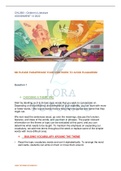CHL2601: Children’s Literature
ASSIGNMENT 13 2022
NB PLEASE PARAPHRASE YOUR OWN WORK TO AVOID PLAGIARISM
Question 1
CHOOSING A THEME AND
Start by deciding on 5 to 8 main topic words that you wish to concentrate on.
Depending on the proficiency and demands of your students, you can start with more
or fewer words. I like to pick words that my kids might recognize and some that they
might not.
We next read the sentences aloud, go over the meanings, discuss the function,
features, and class of the words, and use them in phrases. The pupils' relevant
information on the theme or topic can be evaluated at this point, and you can
determine what needs to be taught. To maintain the emphasis on expanding our
vocabulary, we add new terms throughout the week or replace some of the simpler
words with more difficult ones.
BUILDING VOCABULARY AROUND THE THEME
• Read the topic vocabulary words and sort it alphabetically. To arrange the word
wall cards, students can write on them or move them around.
LORA TUTORING 0734281553
,• Select two terms to contrast and compare in a conversation or with the use of a
Venn diagram.
Additionally, this is a fantastic approach to target a feature, function, or class.
• Let pupils choose a word and illustrate it to show that they understand the
vocabulary term. Choose one to three words, then ask students to create a
statement containing them all.
DEVELOPING A WRITING FRAMEWORK
• Establish, maintain and consolidate.
• Establish purpose for reading and determine the text type
• The pupils collaborate in groups of three or two. A portion of a narrative is read
aloud by the teacher, who then instructs the class on how to continue the story in
pairs. (Typically, this entails introducing dialogue or description.)
• After the learners have supplied a section to the story, the teacher will dictate the
following section and urge them to add more.
• This procedure can go on for five or six paragraphs or up until participants
become focused.
• Give the pupils enough time to practice using sound effects and playing their
roles.
• The stories are then all heard by the kids.
• Asking your pupils to create a few comprehensions check questions for their
stories might help you concentrate their attention throughout the listening activity.
GUIDING LEARNERS THROUGH THE DIFFERENT PHASES OF WRITING
AND EDITING AND IMPROVING ON THEIR DRAFTS
Though the use of the following phases which are: Semi-phonetic phase, Pre-
communicative phase, Phonetic phase, Transitional and Orthographically correct I
can guide my pupils in writing and editing drafts.
1|Page
, • During the planning phase, learners need to understand what it is they need to
write about, and then generate ideas accordingly. This can be done with the
help of a visual diagram where ideas are organised under suitable headings.
• The purpose of writing a draft is not to write the same story twice or find all the
spelling errors, but to teach the learners that writing is a process. We seldom do
our best on the first go.
• Drafting involves grouping ideas, reading, changing and adding, until the
learner is satisfied. Teachers need to ensure that revision is done, since most
learners are quite satisfied with their draft.
• Revising is also not just proof-reading the draft – it has to be re-examined and
re-evaluated. If left to their own devices, learners will read their work once and
correct one or two spelling mistakes
ASSISTING LEARNERS WITH THE ILLUSTRATIONS AND LAY-OUT
• The text and the illustrations in picture books should always complement each
other Because babies and very small children respond to stories told visually as
well as verbally, some picture books are quite effective with no words at all.
• Large illustrations can help leaners to improve their reading. When children
have not yet fully developed their reading skills, they are still able to retell a
story in their own words after “reading” the illustrations.
• It is important to match illustration because The success of the book will depend
on how well the text and the illustrations are woven together to captivate the
child’s imagination
• . Teaching children to identify various visual elements in illustrations could
enhance their creativity and imagination and will help them see their world in a
richer manner.
• Using the artistic style like: Cartoon art, realism, Expressionism and surrealism
can play an important role as it will bring more knowledge to learners
PLANNING AND HOSTING A BOOK-FAIR WHERE LEARNERS’ BOOKS
WILL BE ON DISPLAY AND LEARNERS WILL HAVE THE OPPORTUNITY
TO READ THEIR BOOKS TO AN AUDIENCE
• Identify potential books that contain characters who struggle with a
similar issue.
• Identify a specific problem that you want to address.
• Review the books to determine whether the texts are appropriate for
learners.
• Develop your lesson.
• follow up with an activity such as role-playing scenarios, introspective
writing, creative drawing and writing projects, as well as discussions are
PROVIDING LEARNERS WITH OPPORTUNITIES FOR REFLECTION AND
SELF-ASSESSMENT.
• The purpose of self-assessment and self-reflection in education is to
strengthen a student's capacity for academic and learning results. Then
providing learners with the two aspects will be a great beneficiary to
them.
2|Page




